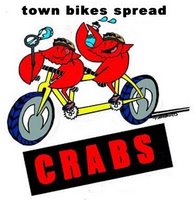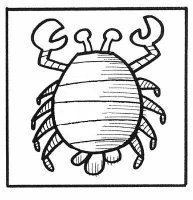
Seafood Surprise; or
"Just when you thought it was safe to go back in the water..."
THE FACTS ABOUT CRABS
"Just when you thought it was safe to go back in the water..."
THE FACTS ABOUT CRABS

|
Pubic lice (often called "crabs" because of their crab-like appearance under a microscope) are six-legged creatures that infest the hair in the pubic area. They can also infest other body hair, but they prefer the pubic region. Although pubic lice infestation, called pediculosis, is considered a sexually transmitted disease (STD), it can be contracted in other ways.
Signs and Symptoms Each female pubic louse (the singular of lice) lays about 30 eggs (called nits) - about two to three per day - over its lifespan. The eggs hatch in about 10 days. If the infestation consists of many adult lice, symptoms may be noticeable immediately. But if the infestation initially involves only a few lice that then lay eggs, a person may not experience any symptoms for 2 to 4 weeks until the eggs hatch. Although it's possible to be infested with pubic lice and have no symptoms, people with pubic lice usually experience itchiness. This can worsen at night when the lice become active and bury their heads inside pubic hair follicles to feed on human blood. Sometimes, lice bites can also cause the infested area to become inflamed because of a reaction to the proteins in the saliva of the louse. Constant itching and scratching can cause the area to become raw, resulting in a secondary bacterial infection. Scratching can also help the pubic lice to spread. If lice infest the eyebrows or eyelashes, the eyes may also become inflamed. Diagnosis An examination of the external genital region infested with pubic lice can show small gray-white oval eggs (nits) attached to the hair shaft and may reveal adult lice. Adult pubic lice can be easily identified under the microscope, but they can be difficult to see with the naked eye because of their location and appearance. Gray-white pubic lice blend in with white skin, and brown lice can be mistaken for moles and are hard to see on black skin. They are not usually as large as the bottom loop on this a. The doctor may also notice scratch marks and secondary bacterial infections such as impetigo. Contagiousness Pubic lice are usually transmitted through direct physical contact, especially with the genital area. Occasionally, transmission can occur through contact with the infested person's sheets, towels, or clothes. (Pubic lice are capable of reproducing about 2 weeks after they're born, but they can live apart from a human body for only 1 to 2 days. Nits live no longer than a few days in clothing or bedding.) But contrary to what some people may think, pubic lice are rarely transmitted from furniture or toilet seats - because the lice that fall from the body are usually injured or dying. Unlike fleas, lice can't jump from person to person. And they can't be contracted from animals. Prevention Because pubic lice are considered an STD, an infestation can be avoided by not having sex or by having sex only with one uninfested partner. Pubic lice can also be contracted from bedding and towels used by an infested person, so it's important to avoid contact with any item - including clothing - that a person who's infested has used. Treatment Normally, an infestation of pubic lice does not require professional treatment. Pubic lice can be treated with over-the-counter medicated shampoos used to treat head lice. Check the product label or ask doctor if the treatment is gentle enough to use in the pubic area. (It's important to note, though, that lice treatments containing the pesticide lindane are not recommended in the United States.) Following the shampooing, comb the pubic hair with a fine-tooth comb to remove nits. Applying vinegar to the pubic hair may help loosen the eggs, but the hair should be dry before applying the shampoo. Though one application is usually all that's needed, your doctor may recommend another treatment 1 to 2 weeks after the initial infestation to break the cycle. Medicated shampoos, creams, and lotions can get rid of the lice immediately, but it may take several weeks for the itching and irritation to go away. If the infestation is substantial, you may want to visit your doctor for a prescription-strength treatment shampoo that you can use at home. If the area is raw or has open lesions from scratching, antibiotics may be prescribed for a secondary bacterial infection that may be present. Because pubic lice can live in bedding and clothing, these items must be treated to stop the infestation. Wash all clothing and linens in hot water, then put them in the hot cycle of the dryer for at least 20 minutes. Items that can't be washed can be sealed in airtight plastic bags for 10 to 14 days before reuse. It's also important to make everyone who has come in contact with the infested person or the infested linens aware of the infestation so they can also be treated. |